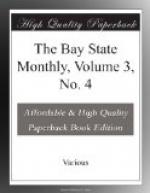This old house teems with historical associations, past and present. Under its roof Mrs. Anne Hutchinson was wont to hold her Antinomian seances, under the very nose of Governor John Winthrop, when “over against the site of the Old Corner Store dwelt the notables of the town,—the governor, the elder of the church, the captain of the artillery company, and the most needful of the craftsmen and artificers of the humble plantation; and at a short distance from it were the meeting-house, the market-house, the town-house, the school-house, and the ever-flowing spring of pure water.”
The Old Corner Store is supposed to have been built directly after the fire of 1711. It is an example of what is known as the colonial style of architecture, and is thought to be the oldest brick building now standing in Boston. Upon a tablet on its western gable appears the supposed date of its construction, 1712.
[Illustration: PORTRAIT OF W.D. TICKNOR.]
After passing through several ownerships the house reverted, in 1755, to the descendants of the Hutchinson family. In 1784 it belonged to Mr. Edward Sohier and his wife Susanna (Brimmer), and was valued at L1,600. In 1795 it came into the possession of Mr. Herman Brimmer, and was designated in the first Boston Directory (1789) as No. 76 Cornhill. In 1817 the front part of the building was used as an apothecary shop, by Dr. Samuel Clarke, the father of Rev. James Freeman Clarke. In 1824 the name of Cornhill was changed to Washington street, and the old store was variously numbered until it took No. 135. Here Dr. Clarke remained keeping shop until 1828, when he was succeeded by a firm of booksellers. After he left, the building was considerably changed, inside and out, and Messrs. Richard B. Carter and Charles J. Hendee then occupied the front room as a bookstore, in 1828, and Mr. Isaac R. Butts moved his printing-office from Wilson’s Lane to the chambers soon afterwards. Messrs. Carter and Hendee continued in the store until 1832, when they removed to No. 131, upstairs, and were succeeded by John Allen and William D. Ticknor in 1832-34. From 1834 the store was occupied by Mr. W.D. Ticknor alone until 1845; and subsequently by himself and partners, Mr. John Reed, Jr., and James T. Fields, until the spring of 1864, when the senior partner died. The new firm of Ticknor (Howard M.), Fields (James T.), and Osgood (James R.) remained at the Old Corner till 1867, when they removed to No. 124 Tremont street. Messrs. E.P. Dutton & Co. next moved into the Old Corner Store, and was succeeded, September 1, 1869, by Alexander Williams & Co. The store is now occupied, since 1882, by Messrs. Cupples, Upham, & Co., well-known book publishers.
[Illustration: THE OLD CORNER IN 1800.]




